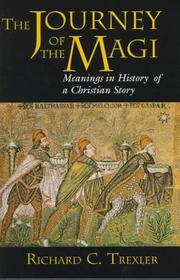| Listing 1 - 3 of 3 |
Sort by
|
Book
ISBN: 9782200353971 2200353979 Year: 2009 Publisher: Paris Collin
Abstract | Keywords | Export | Availability | Bookmark
 Loading...
Loading...Choose an application
- Reference Manager
- EndNote
- RefWorks (Direct export to RefWorks)
"Dans l’Évangile selon Matthieu, les mages venus d’Orient guidés par l’éclat d’une étoile, rendent hommage à l’Enfant Jésus, lui offrant de l’or, de l’encens et de la myrrhe. Avec eux, tout ce que la Terre recèle de somptuosité et de puissance sacrée vient s’incliner devant la faiblesse d’un enfant dont la royauté est infiniment supérieure à la leur. C’est l’Épiphanie, qui fut plus célébrée que Noël, et qui reste une fête majeure. Des premières célébrations dans la chrétienté orientale aux galettes et couronnes d’aujourd’hui, la légende n’a cessé de connaître de multiples interprétations, en passant par ses métamorphoses médiévales et modernes. Dans l’entrelacs des conceptions populaires et des redéfinitions théologiques ou politiques, elle est un extraordinaire révélateur de nos permanences culturelles et de nos évolutions. Sait-on, par exemple, que c’est très tardivement qu’un des mages est figuré en Noir, à l’heure des Grandes Découvertes, quand l’Occident chrétien s’ouvre au monde ? que l’Épiphanie a beaucoup servi ensuite dans des versions « métissées » ? Il fallait le talent unique de Richard C. Trexler pour nous conter cette histoire captivante, tout en nous en faisant percevoir le sens profond."
Magi --- Cult --- History --- Magi - Cult - History --- Magi - Art --- Jésus-Christ --- Rois mages --- Étoile des Mages --- Épiphanie (fête) --- Nativité --- Légendes --- Histoire et critique

ISBN: 3792803763 9783792803769 Year: 1975 Volume: 94 Publisher: Bonn Röhrscheid
Abstract | Keywords | Export | Availability | Bookmark
 Loading...
Loading...Choose an application
- Reference Manager
- EndNote
- RefWorks (Direct export to RefWorks)
Magi --- Cult --- History of doctrines --- 235.3*15 --- -Three Kings (Magi) --- Three Wise Men (Magi) --- Wise Men (Magi) --- Epiphany --- Hagiografie: vereringsgeschiedenis --- -History of doctrines --- -Magi --- -Hagiografie: vereringsgeschiedenis --- -235.3*15 --- 235.3*15 Hagiografie: vereringsgeschiedenis --- -235.3*15 Hagiografie: vereringsgeschiedenis --- Three Kings (Magi) --- Magi - Cult - History of doctrines - Middle Ages, 600-1500

ISBN: 0691011265 1306983991 0691606293 1400864585 9780691011264 Year: 1997 Publisher: Princeton (N.J.): Princeton university press
Abstract | Keywords | Export | Availability | Bookmark
 Loading...
Loading...Choose an application
- Reference Manager
- EndNote
- RefWorks (Direct export to RefWorks)
Matthew's Gospel reveals little about the three wealthy visitors said to have presented gifts to the infant Jesus. Yet hundreds of generations of Christians have embellished that image of the Three Kings or Magi for a myriad of social and political as well as spiritual purposes. Here Richard Trexler closely examines how this story has been interpreted and used throughout the centuries. Biblically, the Journey of the Magi presents a positive image of worldly power, depicting the faithful in progress toward their God and conveying the importance of the gift-giving laity as legitimators of their deity. With this in mind, Trexler explains in particular how Western societies have molded the story to describe and augment their own power--before the infant God and among themselves.The author demonstrates how the magi as a group functioned in Christian society. For example, magi plays, processions, and images taught people how to pray and behave in reverential contexts; they featured monarchs and heads of republics who enacted the roles of the magi to legitimate their rule; and they constrained native Americans to fall in line behind the magi to instill in them loyalty toward the European world order. However, Trexler also shows these philosopher-kings as competitive among each other, as were groups of different ages, races, and genders in society at large. Originally modeled on representations of the Roman triumphs, the magi have reached the present day as street children wearing crowns of cardboard, proving again the universality of the image for constructing, reinforcing, and even challenging a social hierarchy.Originally published in 1997.The Princeton Legacy Library uses the latest print-on-demand technology to again make available previously out-of-print books from the distinguished backlist of Princeton University Press. These editions preserve the original texts of these important books while presenting them in durable paperback and hardcover editions. The goal of the Princeton Legacy Library is to vastly increase access to the rich scholarly heritage found in the thousands of books published by Princeton University Press since its founding in 1905.
Magi --- Mages --- Cult --- History --- Culte --- Histoire --- History. --- 225*13 --- -Three Kings (Magi) --- Three Wise Men (Magi) --- Wise Men (Magi) --- Epiphany --- Kindsheidevangeliën. Verborgen leven van Jezus --- -History --- -Kindsheidevangeliën. Verborgen leven van Jezus --- 225*13 Kindsheidevangeliën. Verborgen leven van Jezus --- -225*13 Kindsheidevangeliën. Verborgen leven van Jezus --- Three Kings (Magi) --- Cult&delete& --- Magi - Cult - History. --- A.D. (miniseries). --- Adoration. --- Adventus (ceremony). --- Alcuin. --- Ancien Régime. --- Apostolic succession. --- Archbishop of Cologne. --- Basilica di Santa Maria Maggiore. --- Basilica. --- Biblical Magi. --- Book of hours. --- Boy bishop. --- Breviary. --- Charivari. --- Chi Rho. --- Christendom. --- Christian republic. --- Christianity. --- Christogram. --- Clement of Alexandria. --- Clergy. --- Confraternity. --- Consecration. --- Counter-Reformation. --- Crusades. --- Curate. --- Dieu. --- Early modern Europe. --- Early modern period. --- Egbert. --- Einhard. --- Evocation. --- Franciscans. --- Frankincense. --- Friar. --- Galerius. --- Henricus. --- Hermeticism. --- Herodian. --- Iconography. --- Imitation of Christ. --- Jacques Callot. --- Jahangir. --- Jan Steen. --- John of Hildesheim. --- John the Evangelist. --- Journey of the Magi. --- Judea. --- Labarum. --- Lactantius. --- Leitmotif. --- Litany. --- Liturgical drama. --- Liutprand of Cremona. --- Lord of the World. --- Magi. --- Major orders. --- Middle Ages. --- Missionary. --- Mithra. --- Mitla. --- Myrrh. --- Narcissism. --- Nativity play. --- Nativity scene. --- New Thought. --- Nicholas of Lyra. --- Offertory. --- Old Testament. --- Orosius. --- Ottonian art. --- Peter Chrysologus. --- Petrarch. --- Pietas. --- Pontiff. --- Pope Gregory VII. --- Pope Leo III. --- Pope. --- Prelate. --- Presbyter. --- Prester John. --- Procession. --- Pseudepigrapha. --- Reincarnation. --- Religion. --- Renaissance Papacy. --- Rite. --- Roland Barthes. --- Society of Jesus. --- Subdeacon. --- Tertullian. --- The Monastery. --- Thomas the Apostle. --- Toltec. --- Transvestism. --- Usury. --- Utrecht Psalter. --- Vestment. --- Wonders of the World. --- Zoroaster.
| Listing 1 - 3 of 3 |
Sort by
|

 Search
Search Feedback
Feedback About UniCat
About UniCat  Help
Help News
News